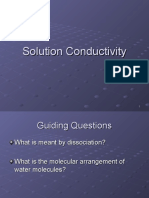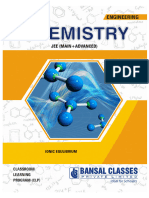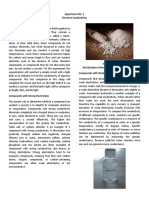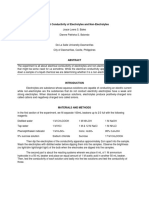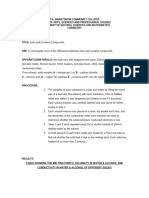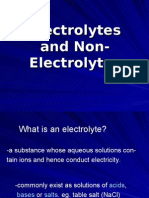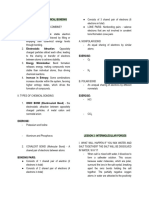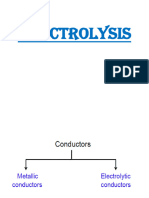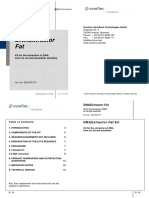Chemistry Rapa
Chemistry Rapa
Uploaded by
Rafael PranaCopyright:
Available Formats
Chemistry Rapa
Chemistry Rapa
Uploaded by
Rafael PranaOriginal Description:
Original Title
Copyright
Available Formats
Share this document
Did you find this document useful?
Is this content inappropriate?
Copyright:
Available Formats
Chemistry Rapa
Chemistry Rapa
Uploaded by
Rafael PranaCopyright:
Available Formats
Name: Rafael Prana Adi W.
Class: X Science 2
Number: 17
ELECTROLYTE AND NONELECTROLYTE SOLUTION
What is the definition of electrolyte substance and electrolyte solution?
Electrolyte substance is a substance that dissolves or breaks down into ions and then the
solution becomes an electrically conductor , the ions are electrically charged atoms . Electrolytes
can be water, acids, bases or other chemical compounds
An electrolyte solution is a solution that generally contains ions, atoms or molecules that have
lost or gained electrons, and is electrically conductive.
What is the definition of nonelectrolyte?
Non-electrolyte solutions are solutions that cannot conduct electric current . This is because the
non-electrolyte solution cannot produce ions (not ionizing).
How does a substance conduct an electric?
A substance can conduct electricity because it has ions which moves freely in the solution. These
ions will be the conductor. The more ions produced the better the solution conducts electricity
There are nonelectrolyte, weak electrolyte, and strong electrolytes in water solvent. Explain the
difference of them! Give the sample of them as much as you can! (Do these question by completing the
following table)
No. The difference Non electrolyte Weak electrolyte Strong electrolyte
1. The ability to conduct unable to conduct weak electrolytes Strong
electric electricity.In non- have relatively low electrolytes have
electrolyte conductivity even relatively high
solutions, dissolved though the conductivity even
nonelectrolyte concentration is though the
substances cannot relatively large. concentration is
be broken down relatively small
into ions, so there
are no free ions that
can conduct electric
current.
2. The ability of the not ionized slight ionization complete
ionization
solute to be ionized (imperfect
ionization),partially
ionized
3. The degree of a=0 a=more than 0 less a=1
than 1
ionization/dissociation value
(α)
4. The experiment result lamp lamp doesn't Produce
doesn't turn turn on/dim much air
- Lamp lightening - Gas
on produce a bubles
bubble
doesn't very few air lamp turn
produce air bubbles on/light
bubbles
Ionization degree is....
the degree of ionization (α) is the quotient of the total number of electrolyte molecules ionized
into ions. The number of concentrations that react or become ions will depend on the degree of
ionization (α) which is formulated as follows: α = Number of moles that are ionized / number of
moles at first.
Sign the following compounds by giving √ if it can conduct electric and – if it can not conduct electric!
Type of compound Solid (s) Liquid/Molten Solution
(l) (in water solvent) (aq)
Ionic compounds - √ √
Polar covalent - - √
compounds
Non polar covalent - - -
compound
Acids, bases, salt and water can be grouped into electrolyte substances. What kind of substances which
can be grouped into strong electrolyte, weak electrolyte, and non electrolyte? Explain your answer!
strong electrolyte
(acid,bases,salt)
because there are has
Characteristics
-Strong or good electric current conductor -Perfectly ionized
-The constant or degree of ionization (a) a = 1
-When tested, a strong electrolyte solution has a bright light and a lot of gas bubbles appear
weak electrolyte
(acid,bases)
it because has characteristics
-Poor or weak electrical conductor -Partially ionized
-Ionization constant or degree (a) 0 <a <1
-When tested, a weak electrolyte solution has a weak flame and a few gas bubbles appear.
non electrolyte (water)
-Cannot conduct current or insulators -The constant or degree of ionization (a) a = 0
-If tested, the Non -Electrolyte Solution, does not ignite and does not appear gas bubbles
You might also like
- MTBE Production Material Balance Project: Process DescriptionDocument39 pagesMTBE Production Material Balance Project: Process Descriptionmoheed100% (1)
- CHM 130LL: Electrolytes Lab: Conduct Electricity. Ions Can Carry Electricity Across A Solution Between The ElectrodesDocument7 pagesCHM 130LL: Electrolytes Lab: Conduct Electricity. Ions Can Carry Electricity Across A Solution Between The Electrodes1828298 18282980% (1)
- KS4 BTEC Science Task Ionic Compounds Exam Style Questions PDFDocument3 pagesKS4 BTEC Science Task Ionic Compounds Exam Style Questions PDFPardon JuniorNo ratings yet
- Periodic Table of ElementsDocument1 pagePeriodic Table of Elementsteknologipangan bthNo ratings yet
- Electrochemistry 19-20Document20 pagesElectrochemistry 19-20system worksNo ratings yet
- Chemistry For Engineers Laboratory 2Document10 pagesChemistry For Engineers Laboratory 2John Melbourne GalvanNo ratings yet
- Tutorial 58Document11 pagesTutorial 58John Mark EliNo ratings yet
- Laboratory Activity 7 MELANDRESDocument6 pagesLaboratory Activity 7 MELANDRESJyzleen SelmaNo ratings yet
- Solution ConductivityDocument13 pagesSolution ConductivityVincent JohnsonNo ratings yet
- Chemistry Unit 2 Study Guide AnswersDocument6 pagesChemistry Unit 2 Study Guide AnswersH.sNo ratings yet
- Electrolyte and Redox: Chemistry ReportDocument7 pagesElectrolyte and Redox: Chemistry ReportGrace KahonoNo ratings yet
- PowerPoint Handouts For Electrolytes and Non-ElectrolytesDocument5 pagesPowerPoint Handouts For Electrolytes and Non-ElectrolytesMsAnn00067% (3)
- Electrolysis 1 TEDocument5 pagesElectrolysis 1 TETom TommmaNo ratings yet
- Ionic Equilibirium in SolutionsDocument4 pagesIonic Equilibirium in SolutionsshaudtddydkNo ratings yet
- PC Ionic Equilibrium EDocument80 pagesPC Ionic Equilibrium Eshashiyadav198700No ratings yet
- Aula T4-5Document48 pagesAula T4-5André MorgadoNo ratings yet
- Covalent and Ionic Properties LabDocument6 pagesCovalent and Ionic Properties LabMadi WellsNo ratings yet
- Electrical Conductivity Laboratory ReportDocument7 pagesElectrical Conductivity Laboratory ReportSteven Lee100% (1)
- Kitchen Chemistry Solubility Melting Point and ConductivityDocument7 pagesKitchen Chemistry Solubility Melting Point and ConductivityMss FaixaNo ratings yet
- Ionic Equilibrium P1-58Document58 pagesIonic Equilibrium P1-58hemant sahooNo ratings yet
- Final Results Table Ionic and Covalent Compound Conduction ExperimentDocument3 pagesFinal Results Table Ionic and Covalent Compound Conduction Experimentniya.sokolova2006No ratings yet
- Ionic EquilibriumDocument93 pagesIonic EquilibriumhappyNo ratings yet
- Reviewer Finals - Anachem LecDocument7 pagesReviewer Finals - Anachem LecJayne DanielleNo ratings yet
- Electrolyte and Non Electrolyte SolutionDocument17 pagesElectrolyte and Non Electrolyte SolutionAnnieSyahidahNo ratings yet
- Scipaper 7Document2 pagesScipaper 7JL Serioso BalesNo ratings yet
- (A) Lec 1Document4 pages(A) Lec 1benedictjdelosreyes03No ratings yet
- The Name's Bonds, Breaking BondsDocument6 pagesThe Name's Bonds, Breaking Bondsapi-348321624No ratings yet
- 01 - To investigate some of the differences between ionic and covalent compounds (1)Document4 pages01 - To investigate some of the differences between ionic and covalent compounds (1)Aisha PetersNo ratings yet
- Identifying An Electrolyte Difference Between Strong and Weak ElectrolytesDocument2 pagesIdentifying An Electrolyte Difference Between Strong and Weak ElectrolytesFelixNo ratings yet
- Summary On Unit 5Document4 pagesSummary On Unit 5buchienjoyerNo ratings yet
- Ion DipoleDocument18 pagesIon DipoleblessyramasamillanoNo ratings yet
- 1.7. Types of ReactionsDocument10 pages1.7. Types of ReactionsRXNOFCHMNo ratings yet
- March 10Document22 pagesMarch 10api-3759646No ratings yet
- WaterDocument2 pagesWaterestoqueaimee9No ratings yet
- Pertemuan 7 - Larutan, Solute, Solven, SolubilityDocument51 pagesPertemuan 7 - Larutan, Solute, Solven, SolubilityNing CahNo ratings yet
- Properties of Ionic and Covalent Compounds LabDocument1 pageProperties of Ionic and Covalent Compounds LabKevonSingh1No ratings yet
- Physical Science Week 5Document3 pagesPhysical Science Week 5Aira EvangelistaNo ratings yet
- G9 Learning GuideDocument17 pagesG9 Learning GuideMary-Rose CasuyonNo ratings yet
- G9 Weeks 1-2 (1-4)Document4 pagesG9 Weeks 1-2 (1-4)Mary-Rose CasuyonNo ratings yet
- Inoic and Covalent CompundsDocument7 pagesInoic and Covalent CompundsDesmond JonesNo ratings yet
- Lesson 3 - Chemical Basis of LifeDocument23 pagesLesson 3 - Chemical Basis of Lifeashleyjade.sundiam.sccNo ratings yet
- Lab Ionic Covalent CompoundsDocument4 pagesLab Ionic Covalent CompoundssanjanaNo ratings yet
- General ChemistryDocument6 pagesGeneral Chemistrychescamagsombol23No ratings yet
- X Chem Master Key Differences 23 - 24Document35 pagesX Chem Master Key Differences 23 - 24zilkag47No ratings yet
- Lecture 06Document15 pagesLecture 06Rebecca WhiteNo ratings yet
- Experiment 5 Dissimilarity Between Ionic and Covalent CompoundsDocument5 pagesExperiment 5 Dissimilarity Between Ionic and Covalent CompoundsNurasyilah YakubNo ratings yet
- Chemistry Ch.4 NotesDocument2 pagesChemistry Ch.4 NotesAnyaNo ratings yet
- Just Read.: Mary Casuyon TNT: 09101206252 TM: 09267238178Document17 pagesJust Read.: Mary Casuyon TNT: 09101206252 TM: 09267238178Mary-Rose CasuyonNo ratings yet
- Q3 General Chemistry IiDocument3 pagesQ3 General Chemistry IiStephen Karl De GuzmanNo ratings yet
- G9 Weeks 5-6 (10-16)Document17 pagesG9 Weeks 5-6 (10-16)Mary-Rose CasuyonNo ratings yet
- ElectrolysisDocument107 pagesElectrolysisminakshi.shitole18No ratings yet
- Quiz Discussion Organic Chemistry Act.Document4 pagesQuiz Discussion Organic Chemistry Act.quirenicoleNo ratings yet
- LABREPORT1Document6 pagesLABREPORT1julinka beyla yansonNo ratings yet
- Electrolyte FixDocument10 pagesElectrolyte FixAirizaNo ratings yet
- Experiment 5 LabrepDocument4 pagesExperiment 5 LabrepDI LacsonNo ratings yet
- Properties of Organic CompoundsDocument2 pagesProperties of Organic CompoundsOrianna SanoNo ratings yet
- Gibme BooookDocument19 pagesGibme BooookDarsheel AmbasthaNo ratings yet
- Water VR 2Document3 pagesWater VR 2estoqueaimee9No ratings yet
- Chemistry - Chang 10th Edition 3Document1 pageChemistry - Chang 10th Edition 3Ayman MurrarNo ratings yet
- Science Reviewer by Aneezah PascualDocument5 pagesScience Reviewer by Aneezah Pascualdalialia136iNo ratings yet
- Chemistry Experiment Chapter 8: Sma Pradita DirgantaraDocument5 pagesChemistry Experiment Chapter 8: Sma Pradita DirgantaraDoni Wahyu PrabowoNo ratings yet
- Imat 2017Document45 pagesImat 2017YarenNo ratings yet
- Lecture 5 CombustionDocument35 pagesLecture 5 CombustionRianyanchaberaNyamesNo ratings yet
- 14.3 Relative Strengths of Acids and Bases - Chemistry LibreTextsDocument1 page14.3 Relative Strengths of Acids and Bases - Chemistry LibreTextsNishali SamNo ratings yet
- Retentor CompressedDocument38 pagesRetentor CompressedLuís Otávio Machado Dos Santos DuarteNo ratings yet
- Oxidation Reduction WorksheetDocument2 pagesOxidation Reduction WorksheetLeigh-Ann AmorosoNo ratings yet
- Geology For Civil Engineers - Chapter 3Document127 pagesGeology For Civil Engineers - Chapter 3Mahamed TingNo ratings yet
- How To Calculate Notice Timedkading Master For Stopping The Cargo... Here Is The Answer - MySeaTimeDocument4 pagesHow To Calculate Notice Timedkading Master For Stopping The Cargo... Here Is The Answer - MySeaTimePHYO MIN ThantNo ratings yet
- KrisDeBruineColorPalette03 2023Document3 pagesKrisDeBruineColorPalette03 2023nigel robertsNo ratings yet
- General Arrangement For Platform & Ladder Acf Condensate Carbon Filter PackageDocument5 pagesGeneral Arrangement For Platform & Ladder Acf Condensate Carbon Filter PackageSonNguyenNo ratings yet
- Rapid Hardening CementDocument3 pagesRapid Hardening CementneekrissNo ratings yet
- SPE-178300-MS Formulation of Local Alkaline-Surfactant-Polymer (Asp) For Enhanced Oil Recovery in Niger Delta: A ReviewDocument16 pagesSPE-178300-MS Formulation of Local Alkaline-Surfactant-Polymer (Asp) For Enhanced Oil Recovery in Niger Delta: A ReviewOSAKWE KELVINNo ratings yet
- Archived Conversion Factor Tables 170118Document12 pagesArchived Conversion Factor Tables 170118Danail Danailov DanailovNo ratings yet
- Chapter 8 EquilibriumDocument99 pagesChapter 8 EquilibriumSimple qaseemNo ratings yet
- Processing Aluminium FoamDocument10 pagesProcessing Aluminium FoamSamuel ArelianoNo ratings yet
- Acids and BasesDocument30 pagesAcids and BasesSwagata SahaNo ratings yet
- Hilti Drilling Screw DocumentDocument8 pagesHilti Drilling Screw DocumentGregory Alan Francisco IINo ratings yet
- DNAExtractor Fat 5224700710 V8 PDFDocument4 pagesDNAExtractor Fat 5224700710 V8 PDFAnisoara HolbanNo ratings yet
- Chemistry Project 01Document14 pagesChemistry Project 01nethratk218No ratings yet
- Chinox 1010Document2 pagesChinox 1010Hai NguyenNo ratings yet
- Who DrugDocument5,107 pagesWho DrugShaila ArunNo ratings yet
- BASF Colors and Effects - Brochure - Orasol Dyes For PrintingDocument10 pagesBASF Colors and Effects - Brochure - Orasol Dyes For PrintingNga VuNo ratings yet
- Shipping LabelDocument2 pagesShipping LabelSeferino EuguiNo ratings yet
- Film Cooling in Rocket Thrust ChamberDocument13 pagesFilm Cooling in Rocket Thrust ChamberNitish KrishnanNo ratings yet
- Biosensor SeminarDocument43 pagesBiosensor SeminarPradeep krNo ratings yet
- Che 91164 AtaglanceDocument2 pagesChe 91164 AtaglanceJo StandleyNo ratings yet
- Design and Fabrication of Cyanide Corrosive-Proof Coating Using Bitumen For Mill Plant Tailing Pipe SystemDocument53 pagesDesign and Fabrication of Cyanide Corrosive-Proof Coating Using Bitumen For Mill Plant Tailing Pipe SystemGwen Ibarra SuaybaguioNo ratings yet
- Cardiolab Practical-PharmacologyDocument2 pagesCardiolab Practical-PharmacologyGul HassanNo ratings yet
- Thermal Processing of FoodDocument23 pagesThermal Processing of FoodDharanibalan PNo ratings yet








